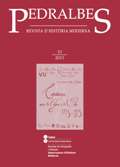Imágenes cartográficas de Cataluña disponibles en el transcurso del siglo XVIII: de la dependencia a la emancipación
Keywords:
maps of Catalonia, 18th century, cartographic patrimony, collecting, historiography, Josep Aparici, Count of Darnius, F.X. GarmaAbstract
Catalonia has a rich cartographic heritage that is in part known and has been studied. Naturally a significant portion of this patrimony dates from the 18th century, a period in which the first examples drawn by Spaniards were pub lished. A corpus of four images stands out above the others thanks to attrib utes such as the amount of information and evocative iconography. More important is its accessibility to the Catalan public, as all these illustrations were on sale in Barcelona. This patrimony has been kept and made known by collectors and has recently been studied by people eager to discover its intel lectual merits and establish its relevance. Rarity and cultural significance ex plain why some of these creations have been issued as facsimile reproductions with a brief monographic study included. Interest in them has to date been essentially documental and geographic, the latter interest concentrating espe cially on the arsenal of territorial data they contain. Driven by other episte mological appreciations, new interpretations are being made which invite us to consider their importance as fabrications at the service of various interests —political or cultural— and to delve into their social effects, both as a vehi cle to express and propagate an identity and promote a geographic imagina tion and forge territorial standpoints.
Downloads
Published
How to Cite
Issue
Section
License
Copyright (c) 2013 Agustín Hernando Rica

This work is licensed under a Creative Commons Attribution-ShareAlike 4.0 International License.
Authors must agree with the following terms:
1. The author keeps authorship rights, ceding the journal the right to first publication.
2. Texts will be disseminated with a Creative Commons Attribution 4.0 International License. Which allows for the work to be shared with third parties, as long as they recognise the work’s authorship, the original publication in the journal and licensing conditions.
This requires acknowledging authorship appropriately, providing a link to the license, and indicating if any changes have been made. It can be indicated in any reasonable way, but not in a manner that suggests the licensor endorses or sponsors the use of the text.
If content is remixed, transformed, or new content is created from the journal's texts, it must be distributed under the same license as the original text



